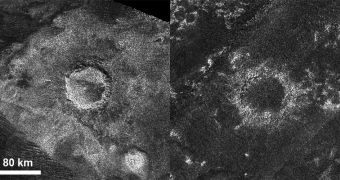Titan is the only other world in the solar system, besides Earth, that is known to have surface lakes and rain. It seems it shares another trait with our planet, sand dunes that move about the surface or some kind of weathering phenomenon unique to Saturn's moon.
Titan is special in the solar system as it's the only moon with liquids on the surface. Unlike on Earth, the liquids are hydrocarbons, methane for example, which become liquid at the frigid temperatures Titan sees.
Scientists analyzing Cassini data have noticed something else peculiar, there are very few craters on the moon's surface and the ones that are there are a lot shallower than similar sized ones on other Saturn moons.
"We found that craters on Titan were on average hundreds of yards (meters) shallower than similarly sized craters on Ganymede, suggesting that some process on Titan is filling its craters," Catherine Neish, from the Cassini team, said. She's the lead author of the paper on the research into Titan's craters.
There are several theories as to why this happens. The most likely, the NASA team believes, is that sand is blown by winds across the moon's surface and slowly fills in the craters.
Erosion from the rain and lakes also contributes to wearing down the craters. It's believed that at least portions of Titan's surface are very soft and marsh-like. The Huygens probe that made it to the moon's surface seven years ago landed in such a soft spot.
Anything that impacts one of these areas will not leave much of a trace as the sediment fills in any large or small topographical features. The same goes for the regions covered by shallow oceans and lakes, like those observed nearer to the poles, any meteorite hitting there would make a visible crater.

 14 DAY TRIAL //
14 DAY TRIAL //